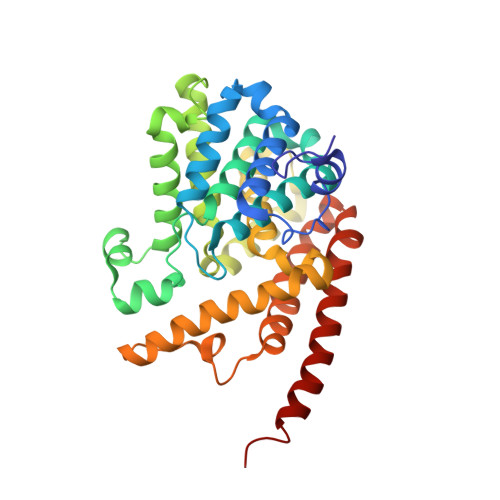Crystal structure of phosphodiesterase 9 shows orientation variation of inhibitor IBMX binding
Huai, Q., Wang, H., Zhang, W., Colman, R.W., Robinson, H., Ke, H.(2004) Proc Natl Acad Sci U S A 101: 9624-9629
- PubMed: 15210993
- DOI: https://doi.org/10.1073/pnas.0401120101
- Primary Citation of Related Structures:
2HD1 - PubMed Abstract:
Cyclic nucleotide phosphodiesterases (PDEs) are enzymes controlling cellular concentrations of the second messengers cAMP and cGMP. The crystal structure of the catalytic domain of PDE9A2, a member of a PDE family specifically hydrolyzing cGMP, has been determined at 2.23-A resolution. The PDE9A2 catalytic domain closely resembles the cAMP-specific PDE4D2 but is significantly different from the cGMP-specific PDE5A1, implying that each individual PDE family has its own characteristic substrate recognition mechanism. The different conformations of the H and M loops between PDE9A2 and PDE5A1 imply their less critical roles in nucleotide recognition. The nonselective inhibitor 3-isobutyl-1-methylxanthine (IBMX) binds to a similar subpocket in the active sites of PDE4, PDE5, and PDE9 and has a common pattern of the binding. However, significantly different orientations and interactions of IBMXs are observed among the three PDE families and also between two monomers of the PDE9A2 dimer. The kinetic properties of the PDE9A2 catalytic domain similar to those of full-length PDE9A imply that the N-terminal regulatory domain does not significantly alter the catalytic activity and the IBMX inhibition.
Organizational Affiliation:
Department of Biochemistry and Biophysics and Lineberger Comprehensive Cancer Center, University of North Carolina, Chapel Hill, NC 27599-7260, USA.




















